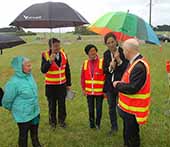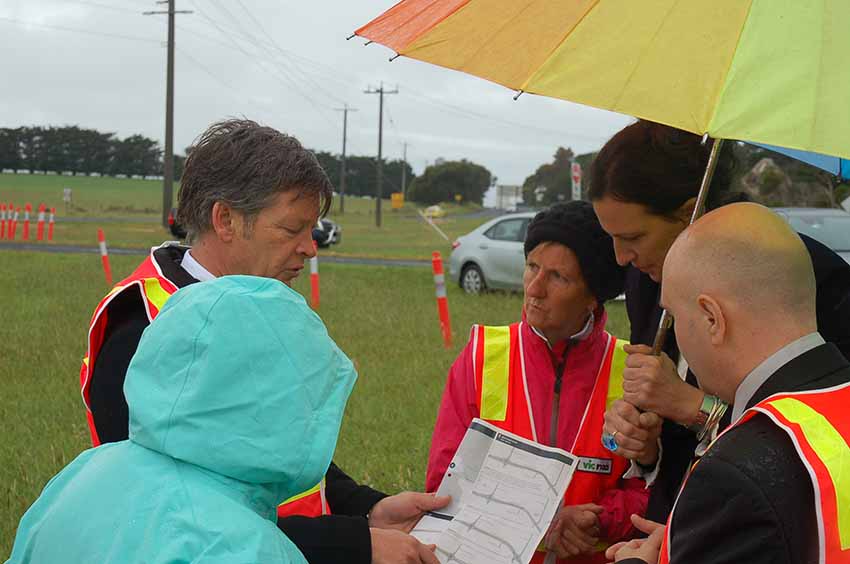
 From left, Roads Minister Luke Donnellan discusses plans with Mary Whelan (community reference group), Bass Coast Mayor Jordan Crugnale, and Scott Lawrence (regional director of VicRoads Eastern Region)
From left, Roads Minister Luke Donnellan discusses plans with Mary Whelan (community reference group), Bass Coast Mayor Jordan Crugnale, and Scott Lawrence (regional director of VicRoads Eastern Region) STATE Roads Minister Luke Donnellan dropped in to Phillip Island yesterday, a sure indication that the State Government is well aware of the island’s major traffic problems.
Mr Donnellan met members of a community reference group on road safety to discuss a proposed $50 million-plus solution to the traffic nightmare that is Phillip Island Road.
Typically between 4000 and 6000 vehicles travel along the road each day, but those traffic volumes more than double during long weekends and the peak tourism season. Since 2006 there have been 121 recorded casualty crashes on Phillip Island Road between Anderson and Cowes. There is also an impact on growth, jobs and economic returns, particularly in the tourism industry.
In the April budget, the State Government announced $3.2 million in funding to conduct infrastructure corridor planning for Phillip Island Road. The funding will enable VicRoads to present a business case by early 2017 for the $50-70 million required to actually solve the problems.
Based on feedback from the community through the Phillip Island Integrated Transport Study, VicRoads has started planning for upgrades and and dual lane roundabouts at Woolamai Beach Road and Back Beach Road.
It is also working with the community regarding improvements to the Newhaven roundabout, where it envisages including a gateway vista to Phillip Island, creating a sense of place and a vibrant and prosperous activity centre with a new service road with more parking to support commercial and tourism growth.
CRG spokesperson Mary Whelan said the community campaign to improve road safety on the island had been a long one involving many people and groups. It started in 2009, when the Brumby State Government made funds available to councils to increase community participation in planning.
Bass Coast Shire Council took up the project and established two pilot programs, including one on Phillip Island covering the settlements of Surf Beach, Sunderland Bay and Smiths Beach, which became the Southern Communities Planning Group.
“Council’s support effectively built community capability,” Ms Whelan said. “After two years the group managed its own agenda and improving road safety became a priority.
“The group always had a positive message that community safety could be improved, we just needed help. Council was always supportive and we corresponded with VicRoads, alerting them to the many problems we had.”
In 2012 after a fatal accident at Surf Beach, the community action increased and a Roads Working Group was formed with residents from across the Island and San Remo now also committed to making roads safe.
That year the group presented a petition with 5000 signatures to Roads Minister Terry Mulder. Later that year the Liberal State Government announced funding for the Phillip Island Integrated Transport Study (PIITS) to develop a community vision for transport on the island. VicRoads also agreed with the group to reduce the speed limit through Surf Beach from 80 to 60km/h.
In 2014 the PIITS was adopted by the council, VicRoads, Department of Economic Development, Roads and Transport, and Public Transport Victoria. Implementation plans commenced.
Part of the recommendations of PIITS was the formation of a Community Reference Group to give the community’s priority for action and to provide feedback on progress.
The CRG encourages the Phillip Island and wider community to attend one of the VicRoads sessions next week to learn more about the plans and to give feedback.
“Participation in the planning process is an opportunity to shape our future,” Ms Whelan said. “The story of the Southern Communities Planning Group is a testimony to this.”